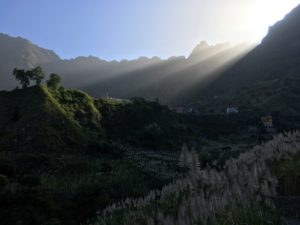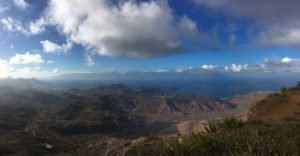Our island specialists Max and Jake travelled to Santiago, Sao Vicente, Santo Antao and Sal in a whirlwind 7-day tour of the islands – this was Max’s first experience of Cape Verde.
Cape Verde has a feel all of it’s own. An island nation, itself consisting of ten islands each of their own character. Independent since 1975. Settled by the Portuguese in 1462 and used as a base for slave trading until the 19th century. Created by a volcanic hotspot. Virtually no rain during 2017 yet with areas of lush and diverse vegetation. Amongst the rocky volcanic coast, beaches of wind-blown Saharan sand please the eye and draw in sun-seekers.
My introduction to Cape Verde was a whirlwind week of island hopping. Away from the stunning beaches and impressive luxury hotels of Sal, the islands of Santiago, Sao Vicente and Santo Antao held both the Cape Verde of those living on the islands, and the Cape Verde landscapes that I was keen to see.
Roughly half of the population of the country live on the island of Santiago, and roughly half of those on Santiago live in the bustling main city of Praia. It’s a heady place to explore, and the colonial past and independent future meet here in the streets. Our guide Tutu showed us around the island. Our first stop was the first European settlement of the tropics once known as Ribeira Grande (Large river) and now known as Cidade Velha (Old City). The streets are preserved but are far from a sterile exhibit – all of the properties are lived in by local families.
The pillory post in the main square of Cidade Velha bears witness to the past – here escaped slaves were whipped or hung. In direct contrast, in the central town of Assomada, Tutu shows us a monument to Amílcar Cabral, the revolutionary leader whose ideas and inspiration were of crucial importance to the independence of both Cape Verde and Guinea-Bissau.

We drive through the dry, towering, rocky, broken mountains of the central landscape of Santiago and arrive at Tarrafal near the northern tip. The beach at Tarrafal is paradisiacal and very quiet – a far cry from the resorts of Sal.

Our return journey is down the road of the east coast which is gradually being upgraded to tarmac, some funds for which come from China. The valleys of the east coast are lush despite the year-long drought, fed by levadas running for miles from water held back by a dam, also Chinese-sponsored. With little natural resources, the country benefits hugely from such investment – as it does from tourism revenue. Tutu shows us several large university buildings specifically to cater for people looking for a career in tourism and leisure.
Sao Vicente is an island dominated by the port of Mindelo. A strikingly impressive natural harbour, Mindelo Bay has an arc of over 180°, the natural shelter completed by it’s northerly aspect and the neigbouring sister isle of Santo Antao. The profile of Monte Cara draws the eye, resembling the face of a reclining giant. Mindelo has a cosmopolitan feel. It’s the second most populous of the cities in Cape Verde at around 70,000 inhabitants. The harbour attracts trans-Atlantic yachts and cargo ships, and it’s from here we take an early ferry to Santo Antao.

Santo Antao is not currently served by an airport and so the majority of journeys to and from the island are by the Mindelo ferry. We negotiated the clamour of taxi drivers touting for business and were whisked away by our driver Dongo straight out up out of the port town of Porto Novo to the crater rim of Cova do Paul at 1,300m. Dongo dropped Jake and I off and we walked into the stunning crater. For the majority of the drive up the mountain, the vegetation was sparse and thirsty. Here at the top of the eastern end of the central spine, the trees and plants are suddenly abundant. Even this surprise did not prepare me for the view at the northern rim, down in to the Paul valley – the path snaking down scores of hairpins, dropping away sharply and soon consumed within the vast landscape consisting of deep and lushly vegetated V-shaped valleys twisting their way finally to the ocean. If you’re after a mountainous island paradise, you’ll find it on Santo Antao.

After our island hopping, we finished our week back on Sal. The majority of Sal I found barren and uninteresting, yet when I reached the coast and beach of Santa Maria, suddenly I could see the point. What an amazing stretch of beach – the archetypical golden sand and azure ocean curving from the plush resorts towards the town of Santa Maria. For time relaxing on a beach, Sal’s the place to be.

We drove from Santa Maria to the salt beds at Pedra de Lume, passing Kite Beach marked by a horizon-full of fast moving kites of the surfers. Walking from the entrance tunnel, the crater floor of Pedra de Lume is revealed – a vast, flat expanse with salt water swimming pools and white salt beds.

After a great last-night meal in Santa Maria we left Cape Verde after a week of diversity that felt more like a month, there was so much crammed in. What an intense 7-night exploratory tour!

Cape Verde Holiday Specialists
At Archipelago Choice, we have a team of Activity Holidays Specialists who know all about Cape Verde and the best ways to explore. They are ready to answer all your questions…
We are a member of AITO (the Association of Independent Tour Operators) which encourages the highest standards in all aspects of tour operating. All members must adhere to the AITO Quality Charter.
Get in touch today to find out more about our adventure holidays on 01768 721040 or email us on:
Email: team@archipelagochoice.com

